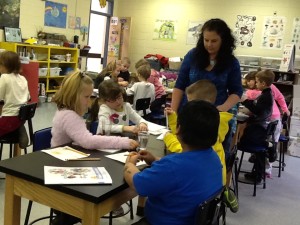Inside a Laser I3 Classroom
Renata Crawley is a LASER i3 teacher at West Marion Elementary School in North Carolina's McDowell County Schools School District. Ms. Crawley has been a teacher for 23 years! Prior to her current position as a science lab instructor, Ms. Crawley taught fifth grade science for four years. The SSEC thanks Ms. Crawley for providing a glimpse into her classroom and school:

Ms. Crawley with her students.
Ms. Crawley, could you tell us a little about yourself and your classroom?
"I teach in a lab setting where students learn about science through hands on, inquiry based lessons. I believe in the "doing" of science. Students work cooperatively in a group setting. When the weather is nice, you will find my students outside in many of our outdoor classrooms, which include a community garden, a nature trail, a stream, an animal tracking box, and a butterfly garden.
I am also the director of GOAL (Get Outside And Learn). GOAL is an after school science club that involves students in grades k-6th. Students meet once a week to learn about the outdoors."
What does "inquiry based learning" mean for you and your students?
"Inquiry based learning allows students to solve answers to questions asked through their own process of discovery. This type of leaning gives students the opportunity to explore through experimentation."
Can you describe how you teach science in your classroom?
"Each week, I collaborate with a specific grade level. For example, one week I will work with all first grade students every day for 45 minutes. Our school is on a 9 week grading system, which allows me to spend one week per grade level during every 9 week period. We also have an exceptional children's wing, an autistic class, and a day treatment facility; these students also come to science lab. Some lessons are teacher created, but I also implement FOSS kits, Delta science kits, and LASER i3 [STC Unit] science kits. This year, I am implementing the first grade LASER i3 kit on soils. This unit lasts longer than one week; therefore, I am rotating first grade classes with other classes. I spend about 4-5 hours a day teaching science. All students are required to have notebooks, except for kindergarten and the exceptional children's classes. Planning for science instruction really depends on what grade level I am working with and if I am implementing a science kit. When I plan a unit on my own, I will spend a great deal of time finding lessons that are exciting, hands on, and meaningful. I have attended several environmental workshops where I received terrific resources, such as Project Wild. These lessons are also integrated into my teaching units. The joy of implementing a science kit is the fact that all the planning has been done and it is research based. I feel confident when teaching from a LASER i3 [STC] kit. It is especially meaningful because I have had training on the kits, and all the materials are provided."
What STC Unit do you and your students enjoy the most?
"My favorite [STC] unit I have taught has been the soils kit for first grade. I love to see the students get excited about the different types of soils. What kid doesn't like to play in the mud? It is something children can relate to because they can make a connection. I love to watch students dissecting the different types of soils. They get excited, they get loud, and they are eager for more leaning. Many leave my room saying they can't wait to come back."
What are some challenges to teaching science you've faced in the past (or currently face)?
"Time will always be a challenge, especially since I only have about 45 minutes to spend with each class. Prep work is also a challenge. That is why I feel the LASER i3 workshops are so helpful. I am able to see and do each lesson."
Do you have any strategies for this that may be useful to other teachers?
"I teach two reading groups in the afternoon, and many days we will read nonfiction literature that is related to what students have learned in science class. The magazines and books provided in the STC kits are also a great source for integrating literature."